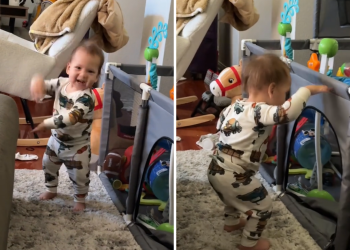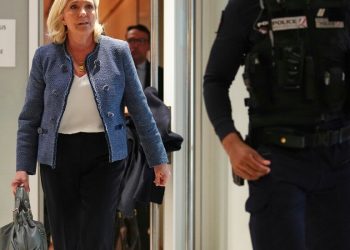
Sarah Abdel Hamid al-Aami holds photos of her 4 brothers who were all accused of terrorism under the Assad regime, and though she came to search posters of dead bodies, she still hasn’t found any signs of them.
Claire Harbage/NPR
hide caption
toggle caption
Claire Harbage/NPR
Warning: This article contains descriptions of torture.
DAMASCUS, Syria – Photographs of tortured and broken bodies are taped to the outside walls of Al-Mujtahid Hospital in central Damascus.
Every day, since the fall of Syrian dictator Bashar al-Assad, a crowd of mothers, sisters, fathers, brothers gather here to examine this wall of terror. They look closely at the bruised corpses with bashed in heads, the gaunt faces with no eyes, the close ups of tattoos and birthmarks to see if any of them belong to their loved ones who disappeared into Syria’s notorious prison system during the 13-year civil war.
At the front, a young woman with a high bun scours every feature on every image. Sarah Abdel Hamid Al-A’ami is searching for her four brothers who were snatched on their way to work by government forces years ago on what she says were bogus accusations of terrorism.
Finally the 23-year-old turns away from the wall and begins to cry.
“I didn’t find my brothers. I didn’t find them,” she cries out. “I swear they didn’t do anything.”
Her grief quickly gives way to anger.
“They killed our children. I want blood for blood, I want soul for soul,” she screams.
She is one of tens of thousands desperately searching for clues to whether their loved ones may be found dead or alive.
Under Assad’s long and oppressive rule even the slightest criticism could land a citizen in prison. Since the uprising against his regime began in 2011, some 157,000 people disappeared into Syria’s prisons and other government facilities according to the Syrian Observatory for Human Rights.
Families like Al-A’ami’s are coming from across the country to look for their missing at prisons, hospitals and morgues. They’re leafing through abandoned prison ledgers, they’re posting missing fliers on the streets of Damascus.

People look in holes in the floor of a room in Sednaya prison. Documents are strewn across the floor. Many families are coming to the prison to look for lost loved ones.
Claire Harbage/NPR
hide caption
toggle caption
Claire Harbage/NPR
As Al-A’ami pulls out pictures of her four brothers — Abdullah, Ibrahim, Ahmed and Mohammed — others crowd around her and do the same.
A mother holds up a picture of her son, another reaches over Al-A’ami’s shoulder with a picture of her child’s ID in her hand. They beg for help from the outside world, for international rights organizations to come and aid in their search, to forensically document the torture and abuse prisoners endured.

Shattered windows at the Iranian embassy in Damascus. A ll over the city are signs of the changes happening in Syria.
Claire Harbage/NPR
hide caption
toggle caption
Claire Harbage/NPR
Searching for Americans
Mouaz Moustafa, the founder of the human rights and aid organization Syrian Emergency Task Force, is on a mission to look for Americans.
On a recent night, the Syrian American activist is in a hurry to get on the road.
“We have a tip that Austin may be in this building. We believe that he may be in the basement,” he says.
He’s referring to the journalist Austin Tice who was detained in Syria in 2012. Authorities believe he was held by the regime.

Mouaz Moustafa works with the non-profit Syrian American Task Force. He’s searching for missing people in Damascus, and after getting a tip is trying to figure out where exactly to look.
Claire Harbage/NPR
hide caption
toggle caption
Claire Harbage/NPR
In the dark of night, Moustafa’s van weaves through the capital where digital billboards light up with the new Syrian flag and the words “Syria Free.”
The vehicle stops at concrete barriers where rebels, now in control of Damascus, guard an air force intelligence building.
Inside, Moustafa and the rebels begin their search.
With no electricity they use the flashlights on their phones to look through abandoned offices and rifle through files.

Moustafa sifts through shredded documents he finds in the former Air Force Intelligence building in Damascus.
Claire Harbage/NPR
hide caption
toggle caption
Claire Harbage/NPR
Moustafa pulls strips of shredded paper from a bin and tries to piece the strips together.
“I’m looking for anything about detainees,” he says. “It’s like looking for a needle in a haystack though, it’s ridiculous.”
He bangs on a locked door.
“Anyone there?” he yells out in English. His question is met with silence.
Whenever he or the rebels see a portrait of Bashar al-Assad or his late father Hafez al-Assad they tear it down.

A picture of Assad lies shattered on the floor of the the former Air Force Intelligence building in Damascus.
Claire Harbage/NPR
hide caption
toggle caption
Claire Harbage/NPR
They step on the glass of framed portraits that have been ripped from the walls.
On one floor of the building a directive is framed and hung in the entryway. It warns employees not to talk to anyone from international organizations or from outside the country. If someone does get in touch, the memo says, report it to the higher ups.
In the basement there are two rooms, both with stairs that disappear into brown liquid.
“It’s a pool of acid,” Moustafa declares. “That’s where they threw people.”
It’s not a claim NPR can verify.

A bed frame sits in a dark room with a brown liquid covering the floor. Moustafa says its a pit of acid where detainees where thrown to die.
Claire Harbage/NPR
hide caption
toggle caption
Claire Harbage/NPR
Down the hall is a row of metal black doors that open to windowless cells. The cold dark rooms are now empty, but the walls are full.

A single mattress lies in a cement cell where Moustafa says a lone prisoner was recently discovered.
Claire Harbage/NPR
hide caption
toggle caption
Claire Harbage/NPR
In one, the Quran is scrawled in tiny lettering so it will fit on the walls.
In the others, the prisoners have etched calendars with every day of the week. Grooves mark each day that’s passed, like someone was counting.
There’s the word mother and a prayer near the once locked exit of one of the cells
“For he who is conscious of God, God will find him a way out.” An arrow points to the door.
When rebels got to this building a few days ago, they say they released a few dozen people held inside.
On this night, it appears there is no one left to find.
But outside the rebels are with a man named Mohamed Sahlan.

Mohamed Sahlan was a prisoner at Sednaya for 4 years. He was detained at a checkpoint on the road from Daraa in southwest Syria to Damascus.
Claire Harbage/NPR
hide caption
toggle caption
Claire Harbage/NPR
He says he walked eight miles from Sednaya Prison, known as “the human slaughterhouse,” on the outskirts of Damascus when the fighters broke them out just a few days ago.
Four years ago he was detained at a checkpoint on the road from Daraa in southwest Syria to Damascus. Soldiers found pictures of the revolutionary flag on his phone and accused him of being a terrorist.
“I would never admit to something that’s not true so he punched me right here,” he says.
He points to his missing teeth where he was hit, his side where he was shot. He says every prisoner in Sednaya had a number. His was 711.

People looking for missing family members walk through Sednaya prison, just North of Damascus, where the Assad regime detained and tortured people.
Claire Harbage/NPR
hide caption
toggle caption
Claire Harbage/NPR
There were days the guards would come and call a few of the numbers out.
“These people would stand and he would just shoot them all in front of us.”
It got so bad that Sahlan lost the will to live.
“I wanted to die. Everyone would rather die than be there,” he said.
As families search for their lost, Sahlan hopes he’ll soon be found.
“All I want to do is see my daughter,” he says.
He doesn’t know if she knows he’s alive. When he was detained his phone was taken with the saved numbers it contained and so much has changed. He’d heard his wife and daughter got asylum outside of Syria so being reunited with his child seems impossible.
“Her name is Sham,” he says. “I think she’s in Canada.”

People search through handwritten notes and log books that are strewn around Sednaya prison just North of Damascus. Many are still looking for loved ones who were detained by the Assad regime.
Claire Harbage/NPR
hide caption
toggle caption
Claire Harbage/NPR
For some, the search for the disappeared has ended. The lucky ones found their people broken but alive. Others have identified bodies like Mazen al-Hamada’s.
The activist was known around the world for exposing the torture inside Syria’s prisons. He was jailed multiple times for demonstrating against the regime since the start of the uprising. After his release in 2013 he was granted asylum in Europe.
There he recounted the disturbing details of his detention. The clamp used to crush his genitals, the rape, the electric shock, the beatings that broke his ribs. For reasons that still confuse even his closest friends he decided he had to go back to Syria in 2020. He was detained immediately and never heard from again. Now his family and friends know he was killed, likely in the final days of Assad’s rule.
But his killing wouldn’t be hidden.
On this day, in an Assad-free Damascus, he is mourned loudly by hundreds in a funeral procession that starts at the hospital where he was identified and ends at his final resting place.
On the side of the roads, the shops are open, and people watch in tears as al-Hamada’s body is held high above the crowd, draped in the revolutionary flag now the new Syrian flag.
Out of the crowd a man with a mustache, a red baseball cap and a wide smile walks up to us.
“Let me speak to you,” he says.

People hold the new Syrian flag during the funeral procession for Syrian activist Mazen al-Hamada.
Claire Harbage/NPR
hide caption
toggle caption
Claire Harbage/NPR
His name is Abdullah Fadel and he translates books. He was a political prisoner from 1992 through 2000. He describes the way he was tortured with a position Syrians call the “German Chair.” He says his arms and legs were strapped to a chair and then the guards would pull his body back. For some it ended with a snapped spine.
Today that’s over.
“I have never dreamed of having such a day. It’s unbelievable. Beyond my imagination,” he says, looking at the crowd chanting for unity and cursing the Assad regime.
“They want to show that they are one people. They have one aim. One goal,” Fadel says. “This is a symbolic funeral. [Hamada] is a symbol of all the people who died in such a way.”
“Look at the images,” he says and points to the posters people hold above their heads with other faces and names of the missing or killed.
Today they get to be celebrated and mourned. The chants that got Hamada and scores of others killed ring through Damascus.




















